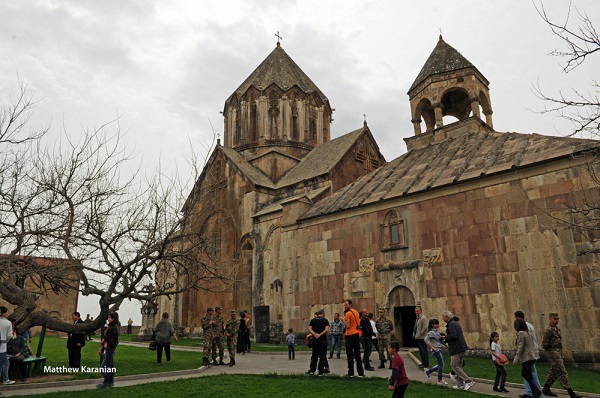Pilgrimage to Artsakh’s Treasure Mountain
\n
Pilgrimage to Artsakh’s Treasure Mountain –
\n
\n
Gandzasar Monastery (Photo by Matthew Karanian)
\n
BY MATTHEW KARANIAN
\n
\n
The Gandzasar Monastery is located about a one hour drive from Karabakh’s capital city of Stepanakert. If this is the only site you visit in Artsakh, your trip will still have been worthwhile.
\n
And if you can make a visit on Easter Sunday, as I did this year, then your visit will be unforgettable.
\n
I had arrived at Gandzasar well before the 10 am starting time for the badarak. The badarak is what you go to when you go to church on a Sunday. It’s the Armenian name for the divine liturgy, or church service.
\n
Dozens of soldiers from the Artsakh Army had already filled the church when I arrived. I wondered if perhaps there was a security issue. Then I realized that they had come to Gandzasar for the badarak, and to participate in the Holy Communion, as had the rest of us.
\n
Their presence served as a reminder, however, of the recent peril Gandzasar has faced.
\n
Twenty-three years ago, Gandzasar was targeted for attack from enemy. There was an attempt to bomb the site. Bombs landed, but not on their target. The story of the impassioned defense of the monastery by its resident archbishop, weapon in hand, has become modern folklore.
\n
The ancient history of Gandzasar reveals a continuous, as well as a magnificent, history of the Armenians of Artsakh.
\n
Construction of the main church, which honors St. John the Baptist (in Armenian, Hovhannes Mkrtich) was begun in AD 1216. According to legend, the church was built at the location of a shrine that contained the skull of this saint, which had been brought here from Palestine.
\n
A high wall, in addition to its natural fortification on a mountaintop, protects the entire complex. The exquisite bas-reliefs on the exterior walls are unique, and have been compared to the elaborate inscriptions of Aghtamar, a church located in the distant region of Van in historic Armenia.
\n
The monasteries of Harichavank, which is located near Gyumri in Armenia, and the monastery of Ohanavank, which is located near Ashtarak in Armenia, are also said to replicate Gandzasar architecturally.
\n
Gandzasar’s bas-reliefs depict the Crucifixion, Adam and Eve, and two ministers holding models of the church above their heads, as an offering to God. There are about 150 separate inscriptions, engraved in stone using the Armenian alphabet, throughout the complex.
\n
In modern times, Gandzasar was the center of an Armenian independence movement in the eighteenth century.
\n
And more recently, the monastery was damaged when Azeri bombers targeted it for destruction in 1991, and one building—the house of the Father Superior—was lost. The damage has been repaired. Extensive renovations and reconstruction were completed in 2004. Controversial “improvements” to the perimeter wall have been ongoing, as well.
\n
The English language translation of the name Gandzasar is “treasure mountain,” and to view the splendor of its architecture is to understand why.
\n
Some scholars and historians consider the monastery to represent one of the top masterpieces of Armenian architecture.
\n
Gandzasar is actively functioning year-round today, as well as on Easter, and is the seat of the Archbishop of Artsakh of the Diocese of the Armenian Apostolic Church.
Adapted from ‘Armenia and Karabakh: The Stone Garden Travel Guide,’ by Matthew Karanian (www.ArmeniaTravelGuide.com).
\n

